I see my path, but I don’t know where it leads. Not knowing where I’m going is what inspires me to travel it. – Rosalia de Castro
Sure, I knew that the Path of the Gods — also known as Il Sentiero degli Dei— technically led to Positano; however, I had no idea what adventure truly lay ahead.
A lot of people tout the pathway as one of the top active Italy adventures and a must-do when hiking the Amalfi Coast.
And there is good reason for this.
If you’re researching things to do in the Amalfi Coast, I will tell you, as someone who has now experienced the Path of the Gods trail for herself, it is definitely NOT overrated
While trying to research how to hike the Path of the Gods, my boyfriend Andy and I found a plethora of information on available tours, but not really a step-by-step guide with a personal account of the experience.
So, I decided to create one myself.
Trust me; you won’t want to miss adding this to your Amalfi Coast itinerary — or even a longer Italy road trip route!
THE PATH OF THE GODS STARTING POINT
Bomerano, not far from the bus stop. What’s important to know if you’re taking the bus is it’ll say “Agerola” or “Agerola (Bomerano).”
I recommend either staying in the town of Amalfi or taking the scenic ferry there. Once in Amalfi, grab the 25-minute bus to Bomerano.
*Note for clarification: The Amalfi Coast is made up of various coastal towns, with Amalfi being one of these towns. Amalfi Coast is the region; Amalfi is a town within the region.
If you’re driving you can simply plug Path of the Gods into Google Maps and it comes up. Click here to grab a pin of the free parking lot right near the trailhead. Once you park, walk and follow Google Maps — and the signs for “Il Sentiero degli Dei” that begin appearing.
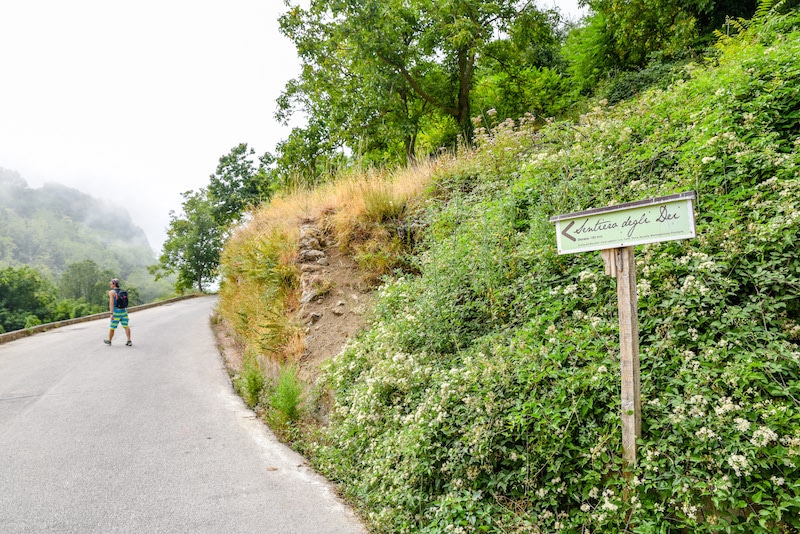
HIKING PATH OF THE GODS: TRAIL BEGINNING
At first this 5-mile hike feels very residential, as you pass terraced farmland dotted with homes growing wine grapes, tomatoes, wheat and more.
The landscape takes me back to years before when I’d hiked the Longji Rice Terraces in China, with sloped hillside winding like a vibrant green snake.
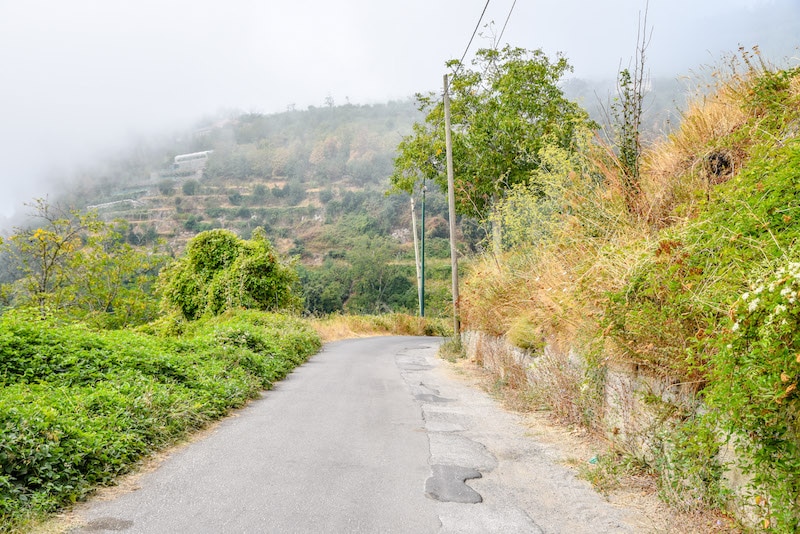

In this beginning section, it’s easy to forget we’re on the coast, as it feels more like Ecuadorian cloud forest than the Italian coast.
As we move farther along the trail though, the view becomes more layered, multiple hillsides saying hello along with pockets of the sparkling Gulf of Salerno and of Naples.
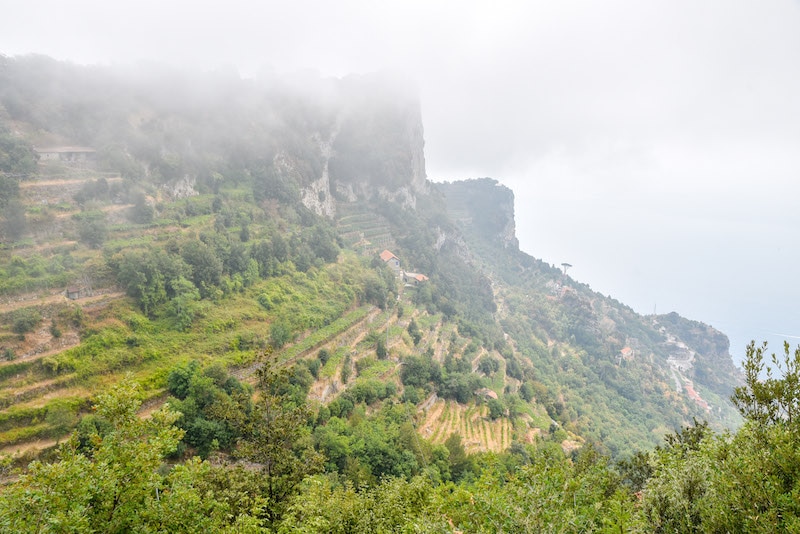
HISTORY OF THE PATH OF THE GODS
We also pass through the “Grotta del Biscotto,” where abandoned centuries-old stone houses sit embedded into the cliff. Scents of thyme, laurel and rosemary waft through the air — typical plants of Agerola you’ll even find in the local food.

According to the New York Times, the Path of the Gods in Italy was “carved out by Greek settlers in the eighth century B.C. and later used by those living in secluded monasteries.”
In terms of the name, the Star Tribute notes the Path was given its title by Italian historian and politician Giustino Fortunato in the mid-1800s.
It stems from the gorgeous views of the sparkling waters and the island of Capri, not to mention the mythological history.
Actually, the story goes that gods came down from heaven to the Path to reach the sea and its “sirens” that sang in an attempt to seduce Ulysses, the king of a small island in the Ionian sea (Ithaca).
HIKING THE AMALFI COAST: FROM LUSH GREEN TO SPARKLING BLUE
Walking the Path of the Gods, it’s easy to see why the gods may have chosen it to visit. A steep roadway soon leads to another ascent, Via Santa Domenica, with multiple religious odes like crosses and nativity scenes.
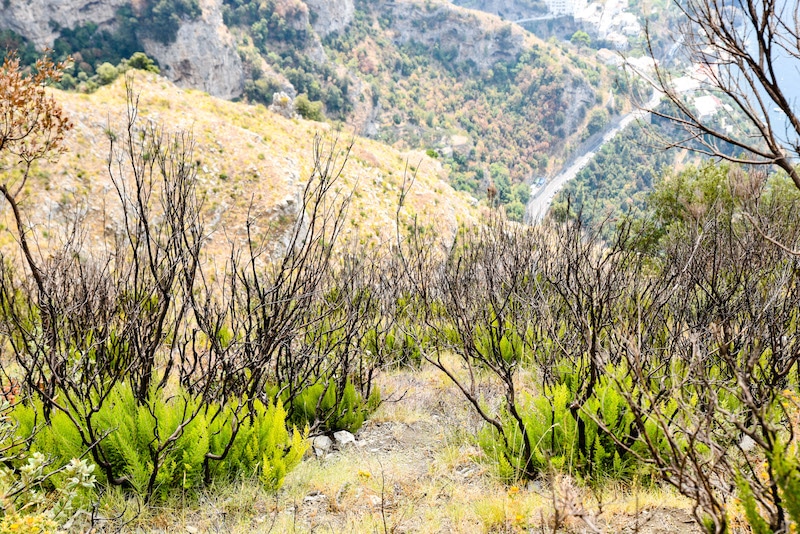
While I went into the trek knowing I’d see the water, I had no idea just how often the landscape and views would change; sometimes slightly, other times dramatically.
While one moment I’m looking out over gnarled brush, the next the sea is sparkling with ripples of hillside beyond it.
Then there would be lush green and delicious plants, followed by a covered forest with a floor coated in leaves or a shady cave.
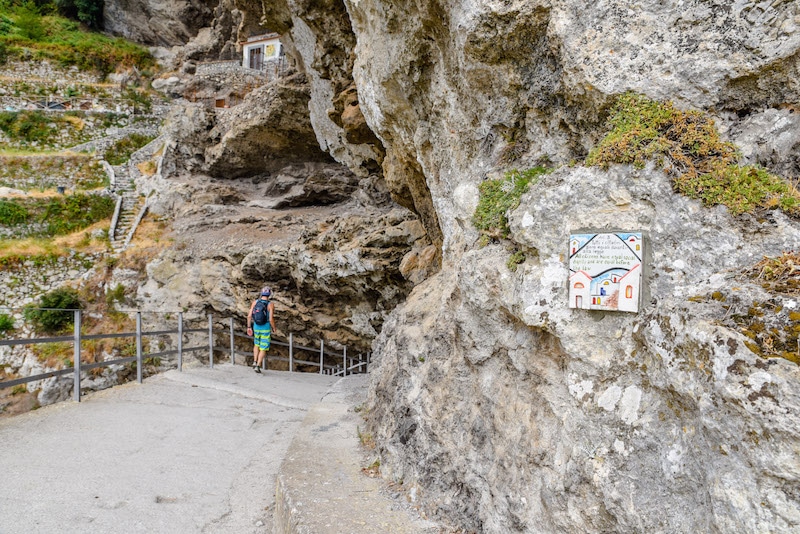
Turning another corner, I might be standing beside a monolith five times my size, gazing out at a random tree that reminds me of the Dragons Bloods of Yemen.
Of course, when near anything with height my rock climber boyfriend Andy feels the need to ascend it.
Actually, there are rock climbing routes.
I tried rock climbing in Croatia and loved it, though looking at the rocky ground and steep drop-offs here makes my palms sweat.
Soon the highlight of the vista becomes the sea, our end point of Positano in view.
So close but so far, as we still have a few hours — and many stairs — to go.

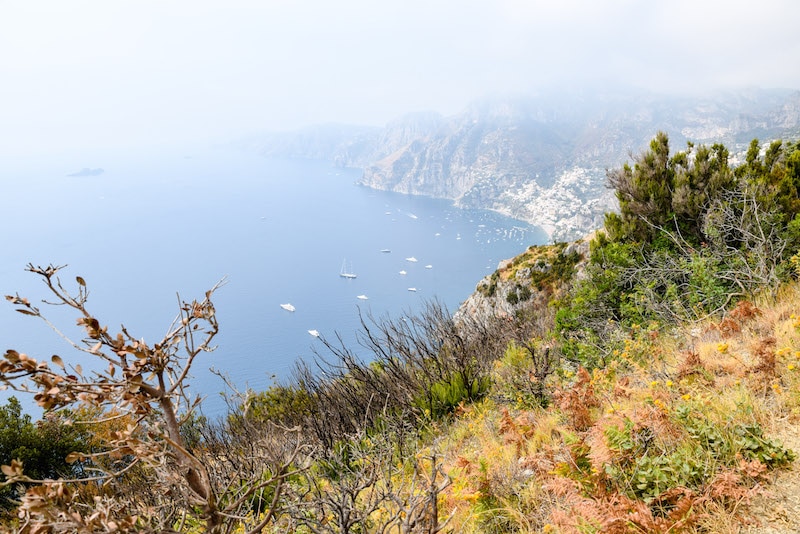
Still, Positano’s gorgeous pastel-colored homes embedded into the terraced cliff side are gorgeous, and are enough motivation to propel us past the uphill climbs.
There are also tiles with uplifting panels mounted onto the rock face. Additionally, numbers count down letting us know when we’ve completed another kilometer; which is great, because there are 7.8 in total!

PATH OF THE GODS AMALFI COAST IS NOT EASY
To be honest, most of the trail is flat, with sections of uneven stone steps. At no point am I gasping for breath, though I wouldn’t call it easy either.
What might make you gasp are some of the viewpoints located precariously close to sheer drop-offs extending a half-mile down (read: this is not for the vertigo-prone!).
I go out onto a few but stay far back enough to keep vertigo at bay.
We see precariously placed homes that seem like the small edge of earth should not hold them, and that the ledge should tumble down, but it stays strong.
A SEASIDE SHOWCASE OF RESILIENT HUMANS
Constantly, Andy and I wonder if we’d be able to live the way these cliffside-dwellers lived — and still do.
Rounding every corner a new, more beautiful Amalfi Coast view appears, which I can’t imagine ever getting old.
However, there’s no denying this was — and is — a resilient culture.
Despite rough, uneven terrain, centuries of people have pushed forward to make the land habitable.
And not only that; but prosperous too with vineyards, lemon groves and vegetable gardens seeming to dangle over the gulf. When they need to travel, mules are used for transport.
UNEXPECTED AMALFI COAST VIEWS ALONG THE WAY
But not all the homes are occupied.
While we knew we’d see gorgeous sea views on this Italy adventure, we didn’t expect to find ruins with doors that ominously invite us in.
Inside, looking at piles of broken wood, I try to imagine who may have inhabited these structures and what they did inside.
What was obvious: whoever spent time in this space had an insane vista. I mean, just look at this:
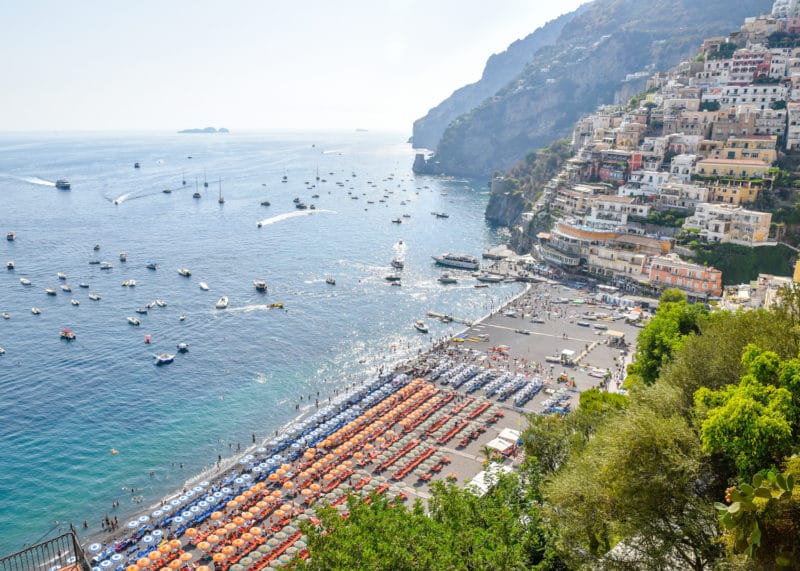
Up and up we climb, getting to closer to the sky as we’re sometimes scrambling over boulders, other times taking small steps up tree trunks-turned-stairs.
The higher we go toward the mushroom clouds, the more patterns I see; not just in the heavens, but in the winding paths below.
Wild shapes take form with outstretched branches and trees meeting the anchored yachts and day boats leisurely floating.
While for a while we walk under the sun, there are times when we’re completely shaded under trees, leaves covering ground once gowned in dust and rock.
Then, a bird’s-eye view of Capri would appear.
As I take it all in, I wonder if there any other Amalfi Coast things to do that even remotely compare to this trek.
A SPRITZ STOP
Back through the forest we climb; and back down the stone steps we descend.
Finally we come to a shaded area where an adorable orange cat walks in front of what must be 100+ cairns.
While I know you shouldn’t make cairns — remember when hiking to always leave no trace — I do snap a photo to capture the awe-inspiring feeling.
In the still quiet, it’s abundantly clear others have come before me, some today, some centuries ago.
Interestingly, in late August we’re practically the only ones on the trail.
At 463 meters high we reach the “Grotte,” where we swap dirt path for rocky climb. Even better, it’s only 0.15 kilometers to Nocelle, which many hikers treat as the end of the trek.
At two hours in I’m starving and needing energy.
Luckily, as we reach Nocelle a small restaurant built into the hillside — a gorgeous terrace jutting out over the emptiness — comes into view.
There’s no name on the door (I find out through Facebook check-in it’s called Il Chiosco), but a chalkboard sign boasts mojitos, homemade limoncello and, most importantly, Aperol Spritz.
Our sweaty bodies and tired limbs don’t need coaxing.
We walk right in, through a dark room with three locals hanging out as if in their living room.
They point to the terrace, and as we step out onto it our jaws literally drop.
It helps that the Spritz’ and paninis we order are delicious; though, even if they hadn’t been this restaurant would have been a worthy stop.
Sitting on the edge, practically dangling off the mountain, we sip and snack in silence, in awe of how small we feel as the valley seems to swallow us up.
A LONG WAY DOWN
I’m so thankful to have stopped for the Spritz, as Andy and I soon find ourselves walking down around 1500 steps (it’s somewhere between 1000 and 1700, depending on who you ask).
If you’re thinking “at least it wasn’t up 1,000 steps,” I wish I had a video of how shaky my legs were with each forward descent.
Soon, we find ourselves jogging down, just wanting to get this last stretch finished with.
Suddenly, though, we notice the signs to Positano have disappeared, and we spill out into the town of Arienzo.
Huh?
After asking a few locals, we realize the path doesn’t continue as a trek, per say, but by walking down the winding coastal Amalfi Drive.
Picture a coastal region full of NASCAR drivers with a death wish, bounding around hairpin turns.
The sidewalks during this leg are super skinny, so we must stay alert.
While slightly harrowing, it’s the way of the coast, and the drivers, while seemingly crazy, are also seemingly aware of pedestrians.
We breathe a sigh of relief as we stroll onto a winding road lined with upscale shops and gluten-free cafes.
Posh Positano is gorgeous, and I love window shopping the unique garments here.
Realistically, however, it’s almost all out of my budget.
One spot we fall in love with is Liquid Art, a gallery with uber-inspiring pieces that trick your vision.
Paper flowers poke out from the wall, airbrushed hues of purple transforming to green as I tilt my head to the right in front of them.
Three ballerinas begin dancing as I walk by, and a man crafted from marble appears to be breaking through a gallery wall, only select limbs in motion visible.
Next door, their sculpture garden offers an al fresco experience, and we continue enjoying the sun by strolling to the beach.
Now, an afternoon at the beach is always welcome; but imagine how good the TyrrhenianSea waters feel on skin that’s just trekked up and down a mountain for three hours.
We aren’t simply enjoying a beach; we earned this beach, and we savor every minute of the swim.
LEAVING POSITANO: A NEW VIEW
We skip the bus and instead choose to take the scenic ferry for 8 Euros back to Amalfi.
Conveniently, a takeaway cocktail stand sits just in front of the ferry dock.
Aperol Spritz’ in hand, we board the ferry and sit on its upper deck during the 25-minute ride to the town of Amalfi.
While the Path of the Gods offered a gorgeous view looking out onto the sea and down the cliffside, the ferry allows us to really take in the challenge we’ve just accomplished.
My tired muscles tell what I’d achieved walking the Path of the Gods, but gazing out over the mountain, the elevated terraced slopes in view, I feel both proud of myself for my accomplishment and thankful for the opportunity to accomplish it.
If you love active adventure on a budget — we spent about $20 USD for a large salami and cheese panini and two cocktails + about $18 USD for two ferry tickets — then you won’t want to miss this incredible hike.